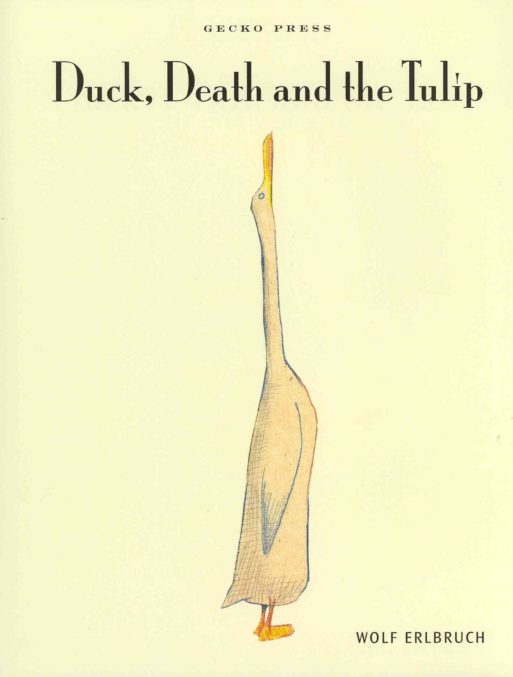 “Duck, Death and the Tulip” is a beautifully illustrated picture book about death and afterlife by German author and illustrator Wolf Elbruch. In the tenderly told story, a duck meets and forges a friendship with Death, a character with a skull for a head who wears a housecoat and slippers. The way Death is illustrated manages to be eerie while at the same time conveying a tender humor.
“Duck, Death and the Tulip” is a beautifully illustrated picture book about death and afterlife by German author and illustrator Wolf Elbruch. In the tenderly told story, a duck meets and forges a friendship with Death, a character with a skull for a head who wears a housecoat and slippers. The way Death is illustrated manages to be eerie while at the same time conveying a tender humor.
At the beginning of the story, Duck becomes aware that she is being followed and becomes frightened by the character with the skull head and checkered robe. Duck asks Death fearfully, “Are you going to make something happen?” Death tells her no, that “life will take care of that.” When Duck asks Death if he’s come to fetch her, he answers that he’s always been there, in case of some unfortunate event: “the coughs and colds and all other things that happen to you ducks.”
The next morning, Duck and Death head down to the pond and consider the afterlife. “Some ducks say you become an angel and sit on a cloud looking over the earth,” Duck says. “Quite possibly,” Death says. “You have the wings already.” Then Duck says, “Some ducks say that there is a place deep in the earth where you will get roasted if you haven’t been good.” Death looks at Duck and says, “You ducks come up with some amazing stories.” Duck gets frustrated when Death indicates that he doesn’t know what happens in the afterlife anymore than Duck does.

Credit: brainpickings.org
At the end of the book, Duck dies. Death tenderly strokes Ducks feathers back into place, picks her up and gently lays her in the Great River, which takes her away. Death “almost” feels moved, but shrugs and says to himself “that’s life.”
That’s the end of the book. There’s no comforting message about what happens after you die, no reassuring affirmation that people (or ducks) live on in the memories of their loved ones. It’s a straightforward, matter of fact story about death that treats the subject rather indifferently and with total acceptance. Yet it still manages to be a sensitively told story, with moving illustrations of the bond between a living creature in it’s final hour and Death, which is portrayed as a perfectly nice, if rather creepy looking, personality.
I’m simply calling “Duck, Death and the Tulip” a picture book rather than a children’s book because I’m not sure this is necessarily the easiest introduction to the concept of death for very young children.

 “Duck, Death and the Tulip” by Wolf Elbruch
“Duck, Death and the Tulip” by Wolf Elbruch


 Recovering Cremation Remains After the Los Angeles Fires
Recovering Cremation Remains After the Los Angeles Fires
 “As Tears Go By” by Marianne Faithfull
“As Tears Go By” by Marianne Faithfull















